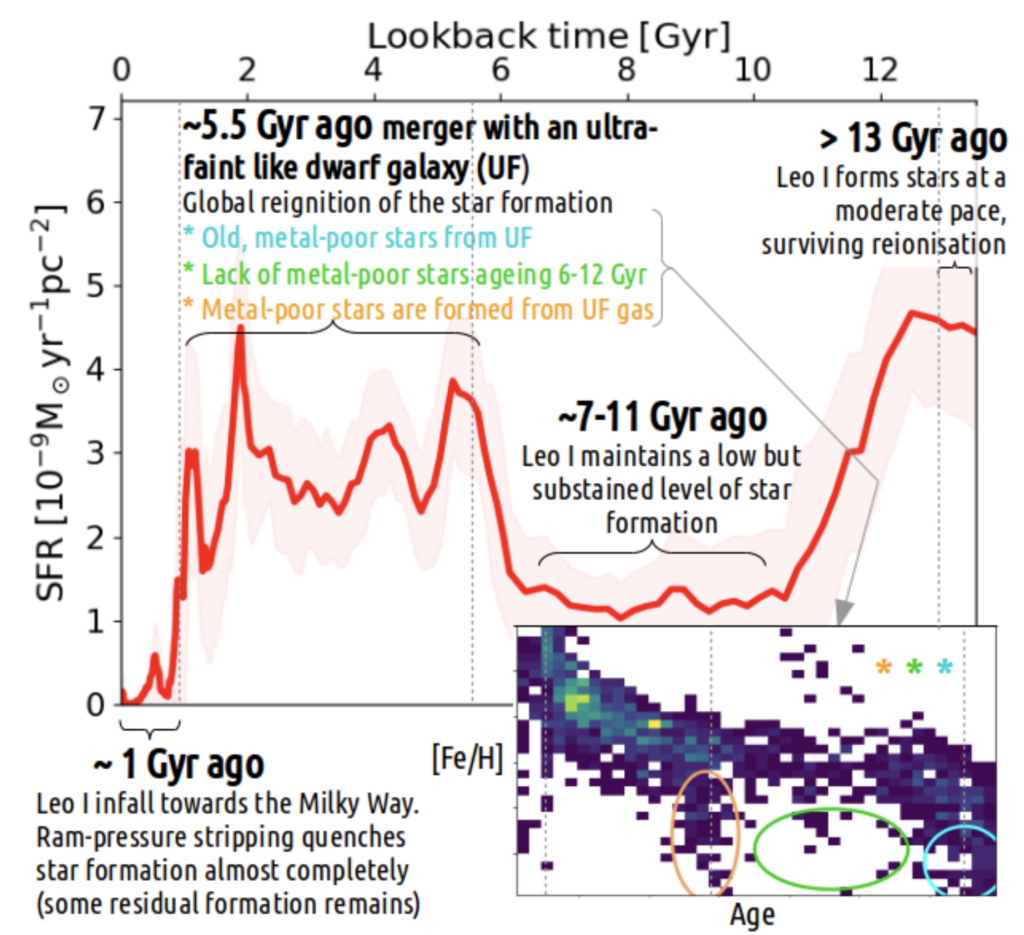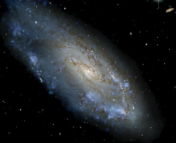Title: Dissecting the stellar content of Leo I: a dwarf irregular caught in transition
Authors: T. Ruiz-Lara, C. Gallart, M. Monelli, T. K. Fritz, G. Battaglia, S. Cassisi, M. Luis Aznar, A. V. Russo Cabrera, I. Rodríguez-Martín, J. J. Salazar-González
First Author’s Institution: Kapteyn Astronomical Institute, University of Groningen, Groningen, The Netherlands; Instituto de Astrofisica de Canarias, La Laguna, Tenerife, Spain; Departamento de Astrofisica, Universidad de La Laguna, La Laguna, Tenerife, Spain
Status: Accepted for publication in MNRAS, open access on arXiv
Not so Bashful
Small, but not to be forgotten, dwarf galaxies represent one of the most important ways of studying galaxy formation and evolution. Dwarf galaxies are the most common type of galaxy in the universe, and may represent an analog of the earliest galaxies to form. Additionally, dwarf galaxies are excellent laboratories for studying cosmology both in terms of their dark matter content and processes involving baryons, like inflows and outflows.
Dwarf galaxies are classified into several different types based on their morphology. On one end are the dwarf spheroidals, which have smooth and clearly defined shapes. The other extreme is the dwarf irregulars, which have patchy, ill-defined structures. An intermediate class of transitional dwarfs spans the extremes. As with galaxy evolution in general, morphology is linked to physical characteristics. The dwarf spheroidal galaxies have less gas than the dwarf irregular galaxies and thus less star formation. It is likely that dwarf galaxies evolve from dwarf irregular to dwarf spheroidal galaxies over time. In today’s paper, the authors study the dwarf galaxy Leo I using deep Hubble Space Telescope data to understand its star formation history.
A Galactic History Lesson
By understanding its stellar population(s) in detail, the authors of today’s paper are able to trace the history of star formation in Leo I. The first thing the authors did was to use a color-magnitude diagram to constrain the evolutionary stages of the various stars living in Leo I. They find that there is evidence for an old population, based on a well-populated red giant branch. However, they also see a strong red clump and hot, blue stars on the main sequence, indicating both an intermediate age and a young (<1 Gyr) population of stars.
Not only is the stellar population of Leo I complex, the dwarf galaxy itself just went through its closest passage to the Milky Way (known as the perigalacticon). The complicated stellar populations and close interaction with a much larger galaxy make Leo I an excellent system for studying a galactic star formation history. To begin this history lesson, the authors measure the metallicities and ages of stars in Leo I to construct an age-metallicity relationship, shown in Figure 1. From this, we see as the galaxy ages, new stars become more metal enriched. Interestingly though, distinct populations of metal-poor stars (the ellipses in Figure 1) tell us about how mergers may have shaped the history of Leo I.

Putting it Together
By modeling the various stellar populations in Leo I, the authors can reconstruct the star formation history of Leo I. Figure 2 shows a detailed scenario of what Leo I may have gone through in the past. Over 13 Gyr ago, Leo I formed stars at a moderate rate. After it depleted some of its gas, it continued to form stars at a low, but roughly constant rate. Approximately 5.5 Gyr ago (the same time as the brown ellipse in Figure 1), Leo I merged with an ultra-faint dwarf galaxy. This both infused Leo I with more gas from which new stars form, but also added old stars from the ultra-faint dwarf. Then, about 1 Gyr ago, Leo I passed close to the Milky Way and most of its gas was stripped away, reducing the star formation to a simmer.

Detailed studies of individual dwarf galaxies like this are difficult, owing to the faintness of these systems. Nonetheless, these studies are crucial to understanding the lowest mass end of the galaxy spectrum. This will become even more important with the launch of the James Webb Space Telescope, with which some of the earliest galaxies in the universe can be studied. Local dwarfs like Leo I can help us place these ancient analogs in context and help us create a full picture of galaxy formation and evolution throughout cosmic time.
Edited by: Luna Zagorac
Featured Image Credit: Sloan Digital Sky Survey (www.sdss.org)




